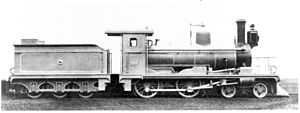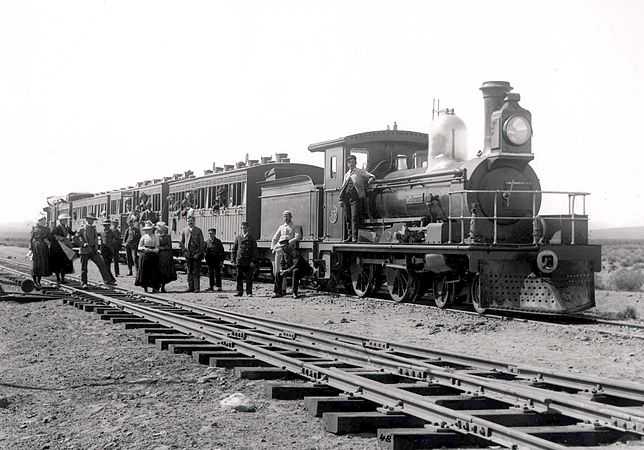CGR 3rd Class 4-4-0 1883
| CGR 3rd Class 4-4-0 1883 to South African Class 03 4-4-0 1883 | |
|---|---|
|
CGR 3rd Class no. M83 "Sir Hercules" | |
| Type and origin | |
| Power type | Steam |
| Designer | Neilson and Company |
| Builder | Neilson and Company |
| Serial number | 2917-2934 |
| Build date | 1882 |
| Total produced | 18 |
| Specifications | |
| Configuration | 4-4-0 "American" |
| Gauge | 3 ft 6 in (1,067 mm) Cape gauge |
| Leading wheel diameter | 27 in (686 mm) |
| Driver diameter | 48 in (1,220 mm) |
| Wheelbase |
6 ft 6 in (1.981 m) drivers 5 ft (1.524 m) bogie 17 ft 9 in (5.410 m) engine 8 ft (2.438 m) tender 34 ft 11 1⁄2 in (10.655 m) total |
| Length | 43 ft 3 in (13.183 m) over couplers |
| Height | 12 ft (3.658 m) |
| Axle load | 9 LT 3 cwt 2 qtr (9.3 t) per driver |
| Weight on drivers | 18 LT 7 cwt (18.6 t) |
| Locomotive weight | 29 LT 16 cwt 2 qtr (30.3 t) w/o |
| Tender weight | 19 LT 12 cwt 3 qtr (20.0 t) w/o |
| Locomotive and tender combined weight | 49 LT 19 cwt 1 qtr (50.8 t) w/o |
| Tender type | Three-axle |
| Fuel type | Coal |
| Fuel capacity | 2 3⁄4 long tons (2.8 t) |
| Water capacity | 1,700 imp gal (7,700 l; 2,000 US gal) |
| Boiler |
10 ft 4 1⁄2 in (3.162 m) length inside 6 ft (1.829 m) pitch |
| Boiler pressure | 130 psi (900 kPa) |
| Firegrate area | 11.25 sq ft (1.045 m2) |
| Heating surface: – Tubes |
145 tubes 1 3⁄4 in (44.4 mm) diameter 690 sq ft (64.103 m2) |
| – Firebox | 62.5 sq ft (5.81 m2) |
| – Total | 752.5 sq ft (69.91 m2) |
| Cylinders | Two |
| Cylinder size |
15 in (381 mm) bore 20 in (508 mm) stroke |
| Valve gear | Joy |
| Performance figures | |
| Tractive effort | 9,140 lbf (40.7 kN) at 75% pressure |
| Career | |
| Operator(s) |
Cape Government Railways OVGS South African Railways |
| Class | CGR 3rd Class, SAR Class 03 |
| Number in class | 18 |
| Number(s) | W77-88, E15-E16, M80-M83 |
| Delivered | 1883 |
| First run | 1883 [1][2][3] |
The CGR 3rd Class 4-4-0 of 1883 was a South African steam locomotive from the pre-Union era in the Cape Colony.
In 1882 the Cape Government Railways placed orders with Neilson and Company for eighteen 3rd Class tender locomotives with a 4-4-0 American type wheel arrangement. They were intended for fast passenger service on all three Cape systems and were delivered early in 1883.[1][2]
Manufacturer
Eighteen 4-4-0 American type tender passenger locomotives were delivered to the Cape Government Railways (CGR) from Neilson and Company in 1883, numbered in the range from W77 to W88 for the Cape Western system, numbers E15 and E16 for the Cape Eastern System and in the range from M80 to M83 for the Cape Midland system. They were ordered in 1882 for passenger service out of Cape Town, East London and Port Elizabeth respectively and were equipped with six-wheeled tenders.[1][2][3]
One of the locomotives is known to have been named, no. M83 "Sir Hercules", after Hercules Robinson, 1st Baron Rosmead, who had succeeded Sir Henry Bartle Frere as High Commissioner for Southern Africa in 1880 and after whom two towns in South Africa were also named. The locomotives became known as the "Four-coupled Joys", from the Joy valve gear that they were equipped with. All these locomotives were later designated 3rd Class when a locomotive classification system was introduced by the CGR.[1]
Service
Cape Government Railways

At the time the Four-coupled Joy locomotives entered service in 1883, the Eastern System mainline from East London was open as far as Queenstown, the two Midland System mainlines from Port Elizabeth were open to Graaff Reinet and approaching Rosmead via Cradock, while the Western System mainline from Beaufort West was approaching De Aar.[4]
As was usual practice with passenger locomotives on the CGR, they were painted green and had polished brass domes. In service, the Joy valve gear proved unsatisfactory and three of the Western System's locomotives were later converted to Stephenson valve gear at the CGR's Salt River shops in Cape Town. Even though this improved their performance, the modification was not carried out on any of the other locomotives.[1]

All these locomotives were renumbered at times during the CGR era. By 1886 the system prefixes had been done away with. The locomotives on the Western System retained their numbers, while the Midland System's locomotives were renumbered from M80 to M83 to the range from 180 to 183. The Eastern System's two locomotives were renumbered from E15 and E16 to 610 and 611 respectively. After the three systems were linked up at De Aar on 31 March 1884, the Midland System's locomotives were renumbered once again by 1888, to the range from 89 to 92 following on from the numbers of the Western System's locomotives.[1][2][4]
Oranje-Vrijstaat Gouwerment-Spoorwegen
In late 1896 some of these locomotives were sold to the Oranje-Vrijstaat Gouwerment-Spoorwegen, where they retained their classification as 3rd Class. The sale possibly involved the five locomotives whose numbers were absent from the roster for the first time by year-end 1896, as set out in the table below.[1]
South African Railways
The Union of South Africa was established on 31 May 1910, in terms of the South Africa Act. One of the clauses in the Act required that the three Colonial Government railways, the CGR, the Natal Government Railways and the Central South African Railways, also be united under one single administration to control and administer the railways, ports and harbours of the Union. While the South African Railways (SAR) came into existence in 1910, the actual classification and renumbering of all the rolling stock of the three constituent railways required careful planning and was only implemented with effect from 1 January 1912.[4][5]
By 1912 only one of these locomotives survived, the Eastern System's no. 611. It was considered obsolete by the SAR, designated Class 03 and renumbered to 0611. By 1918 it had been scrapped.[2][3][5]
Works numbers
The works numbers, original numbers and renumberings of the Cape 3rd Class of 1883 are set out in the table.[1][2][5]
Works no. |
Orig. no. |
1886 no. |
1888 no. |
1890 no. |
1896 no. |
SAR no. |
|---|---|---|---|---|---|---|
| 2917 | W77 | 77 | 77 | 77 | 77 | |
| 2918 | W78 | 78 | 78 | 78 | OVGS? | |
| 2919 | E15 | 610 | 610 | 610 | 610 | |
| 2920 | E16 | 611 | 611 | 611 | 611 | 0611 |
| 2921 | W79 | 79 | 79 | 79 | OVGS? | |
| 2922 | W80 | 80 | 80 | 80 | 80 | |
| 2923 | M80 | 180 | 89 | 89 | 89 | |
| 2924 | M81 | 181 | 90 | 90 | 90 | |
| 2925 | W81 | 81 | 81 | 81 | OVGS? | |
| 2926 | W82 | 82 | 82 | 82 | 82 | |
| 2927 | M82 | 182 | 91 | |||
| 2928 | M83 | 183 | 92 | 92 | 92 | Sir Hercules |
| 2929 | W83 | 83 | 83 | 83 | 83 | |
| 2930 | W84 | 84 | 84 | 84 | 84 | |
| 2931 | W85 | 85 | 85 | 85 | OVGS? | |
| 2932 | W86 | 86 | 86 | 86 | 86 | |
| 2933 | W87 | 87 | 87 | 87 | OVGS? | |
| 2934 | W88 | 88 | 88 | 88 | 88 | |
See also
- CGR 3rd Class 4-4-0 1884
- CGR 3rd Class 4-4-0 1889
- CGR 3rd Class 4-4-0 1898
- CGR 3rd Class 4-4-0 1901
- CGR 3rd Class 4-4-0 1903
- List of South African locomotive classes
- South African locomotive history
- The 4-4-0 "American"
References
|
- ↑ 1.0 1.1 1.2 1.3 1.4 1.5 1.6 1.7 Holland, D.F. (1971). Steam Locomotives of the South African Railways, Volume 1: 1859-1910 (1st ed.). Newton Abbott, Devon: David & Charles. pp. 37–38, 106–108. ISBN 978-0-7153-5382-0.
- ↑ 2.0 2.1 2.2 2.3 2.4 2.5 C.G.R. Numbering Revised, Article by Dave Littley, SA Rail May–June 1993, pp. 94-95.
- ↑ 3.0 3.1 3.2 Paxton, Leith; Bourne, David (1985). Locomotives of the South African Railways (1st ed.). Cape Town: Struik. p. 17. ISBN 0869772112.
- ↑ 4.0 4.1 4.2 The South African Railways - Historical Survey. Editor George Hart, Publisher Bill Hart, Sponsored by Dorbyl Ltd., Published c. 1978, pp. 12-13, 25.
- ↑ 5.0 5.1 5.2 Classification of S.A.R. Engines with Renumbering Lists, issued by the Chief Mechanical Engineer’s Office, Pretoria, January 1912, p. 25. (Reprinted in April 1987 by SATS Museum, R.3125-6/9/11-1000)
